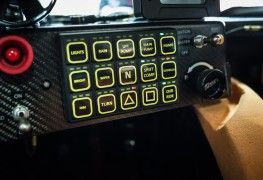The Nissan GT-R LM Nismo is the latest example of how a purely mechanical system can be developed to accomplish the task of hybridizing a car without involving electricity. But before we get into the pros and cons of a purely mechanical system, how does a flywheel system work in these cases? Today it's our turn to tell you.
And to do the explanation efficiently, we'll use a little mathematics, very simple in any case (don't be scared), where we'll work with energies.

Let's take Lucas Ordoñez's Nissan GT-R LM Nismo rolling down the Le Mans straight before reaching the "Forza Motorsport" chicane, right where the speed trap is. Here the GT-R LM Nismo reaches 335 km/h.
At that point its kinetic energy (measured as a half of the mass multiplied by the speed squared) is (a half of 880 kilograms multiplied by 93 meters per second squared) 3,805 MJ. To go through the chicane, the car has to reduce its speed to 105 km/h. So the car has to have a kinetic energy of (an average of 880 kilograms multiplied by 29 meters per second squared) 0.37 MJ.
You don't need a master's degree in physics to realise that the car has to reduce its energy from 3.805 MJ to 0.37 MJ. In other words, 3.435 MJ have to be dissipated. Moreover, it has to be done in a very short time and distance (at the lowest possible braking distance). But for the moment let's forget about how long it takes the car to reduce its energy and how many meters it takes to do so, because those factors have to do with braking power, and not with the aspect that concerns us right now.
To reduce the GT-R LM Nismo's kinetic energy, several physical facts have to be used at the same time:
- Aerodynamic friction: every car, by the mere act of rubbing against the air, slows down. It loses kinetic energy. If you take your foot off the accelerator, the car loses speed, right? When a car rolls at such a high speed and with as many spoilers as the Le Mans cars have, a lot of energy is lost in this way, so when Lucas lifts his right foot, some of the car's energy is lost in moving the air.
- Friction against the ground: The friction of the wheels against the asphalt is also a loss of energy. This energy is converted into heat in the tyre and in the road. It is a relatively small amount that is lost in this way, but it can also be experienced in any wheeled device.
- The brakes: What the braking system does is to cause the wheels to decelerate, which try to turn slower than they are spinning. In this way, the kinetic energy of the car, which is converted into rotational kinetic energy in the wheels, is in turn transformed into friction between the brake disc and the brake pads, which in turn is transformed into heat. In a very intense heat, in fact. This is, along with aerodynamic friction, the biggest contributor to braking the car, and where the most energy is dissipated.
- The flywheel system: But the difference with a conventional car is in the appearance of the flywheel. As in the case of brakes, the principle used to subtract kinetic energy with the flywheel is to try to reduce the rotational speed of the wheels by resisting the flywheel. The beauty of the flywheel system is that instead of converting the wheels' rotational energy (and hence the vehicle's kinetic energy) into heat, as discs and pads do, it stores that captured energy in a rotating body.
The Le Mans regulations, as described by the ACO, allow up to 8 MJ of energy to be recovered on each lap and stored for later use in acceleration. As you can see, in the first braking alone, 3.435 MJ come into play, so as you can imagine, on a circuit with as much high speed braking as Le Mans, it is "easy" to reach that figure of 8 MJ.
The problem is that, no matter how much you want to, not all the energy from each braking can be "stored" in the flywheel system. As I said above, in addition to the flywheel system, there are three other things that come into play. Two are fixed (friction with the air and friction against the ground) and we can't modify them to any great extent to reuse the energy lost in them.
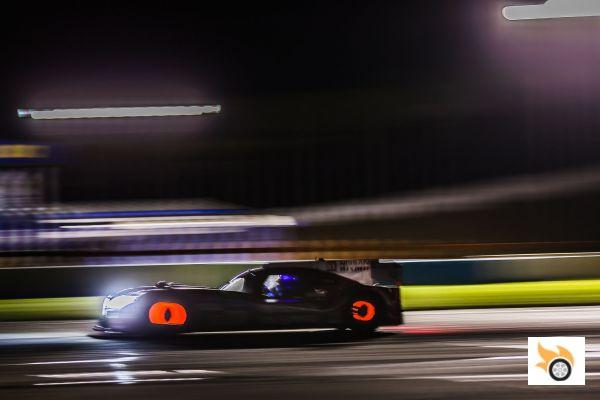
The brakes are still going red, even though they are supported by KERS.
On the other hand, the brakes - flywheel couple can be combined. The idea is to try to use the flywheel to reduce the vehicle's speed as much as possible, and use the brakes only as extra support, since the energy that we subtract from the vehicle when braking by means of the brakes cannot be used later.
How does the flywheel store energy?
But how does the flywheel capture energy? How much energy can we capture with it? These are two key aspects in this whole mess.
How the flywheel works is quite simple. It is basically a flywheel made of carbon fibre and some metal, weighing around 8.5 kilograms, and it rotates around its axis.
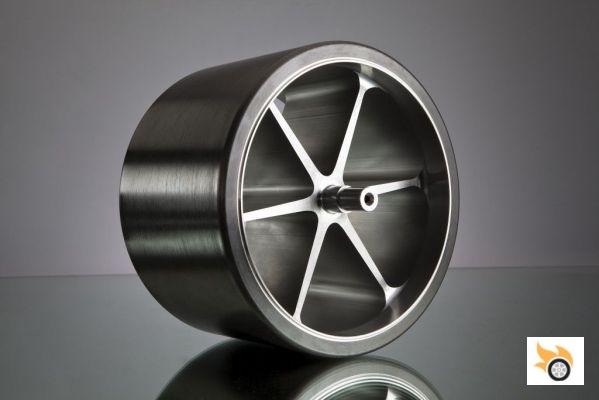
Torotrak Flybrid Carbon Fiber Flywheel
Here another aspect of physics comes into play. In the same way that a body moving at a speed has an energy, when a body spins on an axis, it also has an energy, which is known as rotational kinetic energy.
This is the energy that when a body starts to rotate on itself, it wants to stay rotating permanently unless this energy is removed.
Imagine the wheel of a motorbike or a bicycle spinning freely. Imagine you want to stop it by grabbing it with your hands. If you apply your hands to the tire to stop it, you will burn yourself. That heat that reaches your hands is rotational kinetic energy of the wheel, which has been transformed into friction in your hands, and in turn, has been transformed into heat. Get it?
Well, that's basically the principle of rotational kinetic energy. Inside the body of the flywheel system we have this carbon fibre cylinder rotating. How much energy can it store? Well this depends on the speed at which we can make it rotate, and the polar moment of inertia of the flywheel.
I told you about the polar moment of inertia for something else, but basically it is the number that tells us the tendency of a body to keep spinning around an axis. The further the mass is from the axis, the more "polar moment of inertia" the flywheel has, and therefore, the more energy it stores in its rotation. For this reason, flywheels are designed with almost all of their weight concentrated on the outside of the cylinder.
Basically, the amount of energy that can be stored is the result of multiplying the polar moment of inertia by the maximum rotational speed we can give the flywheel without it breaking, divided by two.
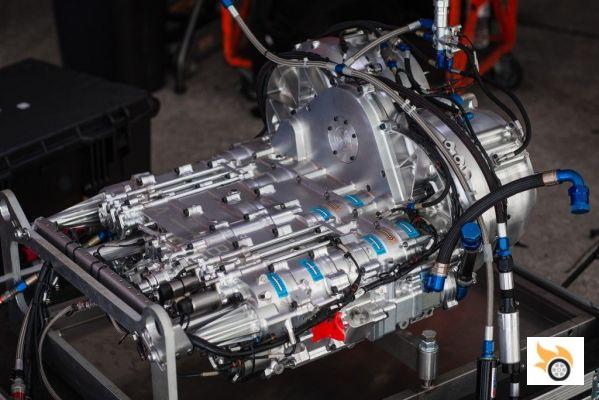
Torotrak Flybrid dual parallel flywheel system for Nissan's GT-R LM Nismo
In the case of the Nissan GT-R LM Nismo, two parallel Torotrak flywheels are used. Each has a mass of 8.5 kilograms, capable of rotating at 65,000 revolutions per minute. Given the characteristics of the system, Torotrak says the system is capable of storing up to 400 kJ of energy per flywheel. If you multiply by two (since you have two flywheels running) you have a total of 800 kJ of storage capacity. As far as we've been able to tell, Nissan has tried to push this system further, and have up to 1,200 kJ (1.2 MJ) in this pair of flywheels, but that's where there have been reliability issues.
How does the flywheel capture energy during braking?
Well, you know from what I've explained above how the flywheel stores energy. But how do you capture the energy from the wheels? Well, it's quite simple.
When Lucas presses on the brake, the flywheel at that moment is still. It is linked by a series of gears and clutches to the front wheels. The front wheels try to turn the flywheel and gradually accelerate it. The more the flywheel is accelerated, the more rotational speed is removed from the wheels, and therefore the slower the car goes. In other words, the car is slowed down by accelerating the flywheel.

In this way, the car can eliminate up to 1.2 MJ of its energy during braking, all of which is transformed into kinetic energy stored in the flywheels, which at that moment are spinning at 65,000 revolutions per minute.
As we told you above, to get the GT-R LM Nismo from 335 mph to 105 mph, 3.435 MJ must be removed, so since only 1.2 are stored in the flywheel, the rest (2.235 MJ) must be dissipated by the brakes and friction from the air and ground. This is where the brakes come into play.
One of the big problems with these cars is to masterfully combine, through electronic controls, what part of the braking work is done by the brake discs, and what part is transferred to the flywheel, and at the same time make everything so that the car brakes in a predictable way for the driver, that is, that it always brakes the same and with the same pedal travel, so that there are no noticeable differences and strange touches that complicate the life of drivers like Lucas. This is really one of the most complicated parts of the system.
But how long can the flywheel store energy?
But by now you're probably thinking... how long does the flywheel last? If you have ever given force to a bike wheel to make it spin freely, you will have noticed that sooner rather than later it ends up stopping, right? It stops mainly because of two factors. One is the friction with the air, and the other is the friction of its bearings (the friction it has when it spins on it, come on).
Bearing friction is something that can never be completely eliminated, but flywheel systems like Torotrak's Flybrid used by Nissan employ a special, well-lubricated bearing system that greatly reduces friction to negligible values.
But the big challenge is friction with the air, especially at rotation speeds of 65,000 revolutions per minute (over a thousand revolutions in a second!). At those speeds, the outermost part of the cylinder travels at a linear speed equivalent to the speed of sound in conventional air. If friction with the air were allowed to occur at those speeds, the carbon fiber would melt from the mere friction with the air.
What Torotrack does is to store the flywheel in a sealed cylinder that has had the air removed. Being in a near vacuum, the flywheel does not suffer the deceleration of the air, so the energy can be stored for minutes without the flywheel decelerating practically, although eventually it would end up stopping by the friction of the bearings.
And when it comes to accelerating?
Once out of the chicane, when Lucas pushes the accelerator pedal to the floor, what the car will try to do is to recover the kinetic energy until it gets up to 300+ per hour again. Some of that kinetic energy will be gained from the combustion engine, which by burning petrol produces energy that is transferred to the wheels, which in turn gradually accelerates the car and makes it gain energy.
But on the other hand, when Lucas presses the pedal, the flywheel control electronics reengages the internal gears and clutches of the flywheel system, to associate it with the front wheels. What it does now is to transfer those 1.2 MJ stored in the flywheel pair and redirect them to the wheels to make them gain rotational speed, and therefore, make the car gain energy.
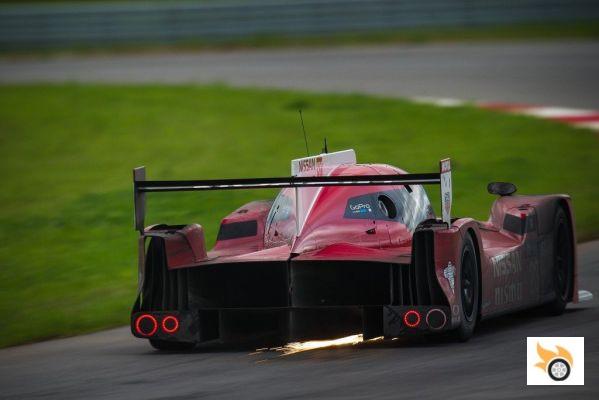
This extra acceleration energy "comes for free", insofar as it has been gained in braking, and would otherwise have been given off in the form of heat in the brakes, and fuel consumption can be saved. In fact, we are re-using up to 30% of the braking energy, which means an instant reduction in fuel consumption.
Depending on the speed at which the flywheel system is able to transfer the stored energy to the wheels, the amount of power it is able to deliver is derived. Nissan's original idea was to have a multiple flywheel system capable of dumping the stored energy all at once to nearly 2,000 horsepower, but the reality of the physical limitations of the current system have meant that, for the time being, the system is at 600 horsepower and 1.2 MJ of power, as we told you earlier.
Problems?
You might think that, given what you've seen, the flywheel system seems much simpler and more logical than a battery or capacitor electric system, and in a way it is.
It is a more energy efficient system (you save converting kinetic energy into electricity, and then electricity into kinetic energy again), which makes better use of the energy captured. It weighs and occupies less volume than an energy storage system to batteries or capacitors of equivalent capacity, and when handling it has no risks such as high voltage discharges.
Another advantage is that it is a system that does not deteriorate over time at the rate that batteries or capacitors do.

Much of the problems in the development of the GT-R LM Nismo have stemmed from the fine tuning of the flywheel system.
But the drawbacks come from other fronts. As we said before, when the car starts braking, the steering wheel will be practically stationary, and will be accelerating. When accelerating, the steering wheel will have a high rotational speed and will have to decelerate to transfer speed to the wheels.
This gradient, this difference in rotational speed between the wheels and the flywheel, is made possible thanks to a gearbox made up of a variator. This variator has to be permanently adjusted to allow the acceleration or deceleration process to be consistent, and to make matters worse, it has to work in parallel to a second variator with a second flywheel. In other words, there is an orgy of gears turning inside the device, and they all have to agree, like a Swiss watch, with extreme precision, governed by electronics that, in addition, must be able to determine how much torque the front wheels can withstand without losing traction or locking up, and what the rider's demands are in acceleration or braking.
It is this last aspect, that of putting all the mechanisms to work in coordination, at the same time and in an organized way, that really generates the problems. In fact, it is this aspect that Nissan has yet to polish with Torotrak. It's from the problems with the fit of these gears and systems that Nissan's problems with being able to pick up and use 8 MJ per lap at Le Mans arise, and are the reason why, for the time being, it has dispensed with using the rear axle as a drive, and decided to go with a more energy-conservative strategy.
However, when Torotrak and Nissan manage to make the device work as the theory says, adjusting its parameters, we will be facing the most efficient system given the current ACO regulations for Le Mans. And then we may be surprised by the results.
The return of Alfa Romeo: from the 1900 to the Giulia

